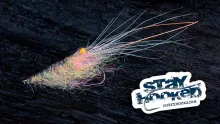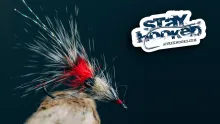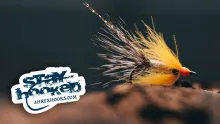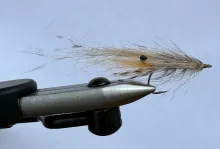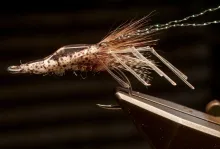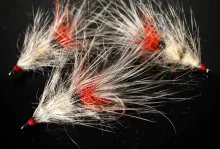An imitation well suited for inshore fishing.
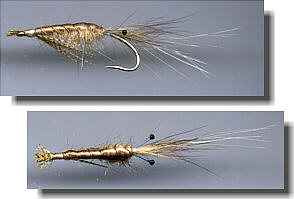
Shrimp make an important part of the sea trout's menu. Many times you can observe shrimp in the water - especially over sand bottom, where their almost translucent body only leaves a faint shadow and maybe a small trail of dust as they escape in a jerk.
This pattern tries to catch some of the characteristics of the shrimp: the light transparent body, the segmentation, the almost invisible antennae and the extremely visible black eyes.
| Hook | 2-4 curved nymph/emerger hook like Tiemco TRM200 |
| Thread | Tan |
| Weight | Bottle lead |
| Antennae | Small tuft of light opossum hair with long guard hairs |
| Shell | Shell back or latex, light brown |
| Eyes | Burned monofilament |
| Rib | Copper wire or monofilament |
| Body | Ball of black dubbing under natural opossum |
| Legs | Barred wood duck |
| Tail | Barred wood duck |
| 'Head' | Tying thread |
- Cut a narrow strip of bottle lead
- Cover the middle of the hook shank with the lead
- Tie in the thread in front of the lead
- Tie down the lead with open, but tight turns of thread
- Tie in a monofilament eye on each side of the hook shank over the barb
- Tie in the ribbing under the eyes pointing toward the hook bend
- Bend each eye perpendicular to the hook shank
- Varnish the lead, bas of eyes and bas of ribbing
- Tie in a tuft of light opossum, guard hairs 1.5-2 times hook length, sticking out between the eyes
- Leave the butts of opossum and cover with tying thread
- Taper a narrow strip of latex and tie in over the eyes pointing toward the hook bend
- Dub a small ball of black dubbing close to the base of the eyes
- Cover the whole body and the black ball with a layer of opossum dubbing. The dubbing needs to be light and transparent
- Leave an eye width or two uncovered behind the hook eye
- Pull the shell over the body and tie down
- Wind the ribbing over the body and shell and tie down under the hook shank
- Tie in a small bunch of wood duck fibers as a false hackle under the hook shank, almost reaching the hook point
- Use the butts of the wood duck to make a short, fanned tail fin over the hook eye
- Finish the fly between the tail fin and the shell with a whip finish and varnish
- Log in to post comments

